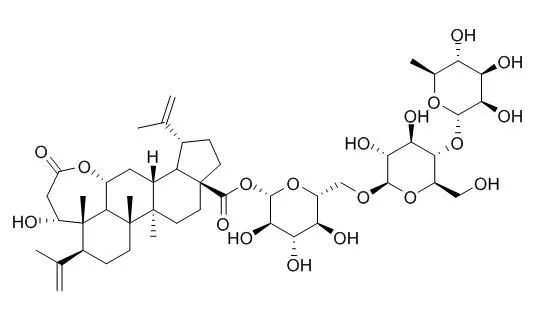| Description: |
Chiisanoside has anti-oxidant, anti-inflammatory, anti-rotaviral activities, it can inhibit xanthine oxidase activity and increase superoxide dismutase (SOD), glutathione peroxidase and catalase, it also inhibits NO and PGE2 production. Chiisanoside has the potential to prevent obesity as a lipase inhibitor which suppresses fat absorption in vivo. |
| In vitro: |
| Biol Pharm Bull. 2005 Oct;28(10):1919-24. | | Inhibition of lipopolysaccharide-induced expression of inducible nitric oxide and cyclooxygenase-2 by chiisanoside via suppression of nuclear factor-kappaB activation in RAW 264.7 macrophage cells.[Pubmed: 16204946] |
METHODS AND RESULTS:
In the present study, the effects of several triterpenes isolated from the leaves of Acanthopanax chiisanensis (Araliaceae), namely, Chiisanoside, isoChiisanoside, 22-hydroxyChiisanoside and chiisanogenin (the aglycone of Chiisanoside) were evaluated on lipopolysaccharide (LPS)-induced nitric oxide (NO) and prostaglandin E2 (PGE2) production by the RAW 264.7 macrophage cell line. Of the triterpenes tested, Chiisanoside was found to most potently inhibit NO and PGE2 production. In addition, Chiisanoside significantly reduced the release of inflammatory cytokines like TNF-alpha and IL-1beta. Consistent with these observations, the protein and mRNA expression levels of iNOS and COX-2 enzyme were found to be inhibited by Chiisanoside in a concentration-dependent manner. Furthermore, Chiisanoside inhibited the nuclear factor-kappaB (NF-kappaB) activation induced by LPS and this was associated with a reduction in p65 protein in the nucleus and with the phosphorylations of ERK1/2 and JNK MAP kinases.
CONCLUSIONS:
Taken together, our data indicate that the anti-inflammatory properties of Chiisanoside might be the result from the inhibition of iNOS, COX-2, TNF-alpha and IL-1beta expression through the down-regulation of NF-kappaB binding activity. | | Biol Pharm Bull. 2001 May;24(5):582-5. | | Metabolism of chiisanoside from Acanthopanax divaricatus var. albeofructus by human intestinal bacteria and its relation to some biological activities.[Pubmed: 11379786] |
METHODS AND RESULTS:
The metabolic pathway of Chiisanoside isolated from leaves of Acanthopanax divaricatus var. albeofructus (Araliaceae) by human intestinal bacteria and by the protein fraction of leaves of this plant were investigated, and the cytotoxic and anti-rotaviral activities of Chiisanoside and its metabolite, chiisanogenin, were assayed. Chiisanogenin was produced as a main metabolite, when Chiisanoside were incubated for 15 h with human intestinal bacteria. This metabolic pathway proceeded more potently with the protein fraction than with human intestinal bacteria.
CONCLUSIONS:
The in vitro cytotoxicity of chiisanogenin was superior to that of Chiisanoside. H+/K+ ATPase was more potently inhibited by chiisanogenin than by Chiisanoside. However, the anti-rotaviral activity of Chiisanoside was more potent than that of chiisanogenin. |
|






 Cell. 2018 Jan 11;172(1-2):249-261.e12. doi: 10.1016/j.cell.2017.12.019.IF=36.216(2019)
Cell. 2018 Jan 11;172(1-2):249-261.e12. doi: 10.1016/j.cell.2017.12.019.IF=36.216(2019) Cell Metab. 2020 Mar 3;31(3):534-548.e5. doi: 10.1016/j.cmet.2020.01.002.IF=22.415(2019)
Cell Metab. 2020 Mar 3;31(3):534-548.e5. doi: 10.1016/j.cmet.2020.01.002.IF=22.415(2019) Mol Cell. 2017 Nov 16;68(4):673-685.e6. doi: 10.1016/j.molcel.2017.10.022.IF=14.548(2019)
Mol Cell. 2017 Nov 16;68(4):673-685.e6. doi: 10.1016/j.molcel.2017.10.022.IF=14.548(2019)